July 2, 2024 marks the tenth anniversary of the launch of the Orbiting Carbon Observatory-2.
On July 11th JPL celebrated the 10th Anniversary of OCO-2:
LinkedIn | Instagram
Huge congratulations and thanks to all who have made it possible to reach this milestone!
In La Niña years, levels of the CO2 usually don’t rise as much as they otherwise would. But in 2021, La Niña’s carbon storage effects were different. Research published in Science Advances suggests that this particular event made little overall difference to the growth in atmospheric CO2 concentrations, probably due to the drought and warmer weather that occurred in Asia that year. If this benefit from La Niña falters in future years, it could have serious implications for climate change. See the feature article on this OCO-2-based study >
A recent study by Kira and co-authors used OCO-2 solar induced fluorescence (SIF) measurements as a key input to a framework to estimate crop yields. This study points to the value of the small OCO-2 footprints in allowing crop-specific SIF information. The results show the promise of satellite SIF measurements to enable developing countries to develop more effective responses to food crises, agricultural policies, and more efficient commodity pricing.
See the study: A scalable crop yield estimation framework based on remote sensing of solar-induced chlorophyll fluorescence (SIF)
The JPL OCO-2 Vicarious Calibration team have just returned from a successful summer campaign in Railroad Valley, NV! The Railroad Valley playa is a dry lakebed with land characteristics uniquely suited for calibrating NASA’s Earth-observing satellites. The OCO-2 team were joined out on the playa by JPL colleagues from the MISR team and by Japanese colleagues from the GOSAT and GOSAT-2 teams, continuing a strong tradition of international collaboration between the OCO and GOSAT missions. The campaign was blessed with clear skies this year, and the teams were able to collect a range of valuable measurements that will inform ongoing analyses of the quality and stability of the calibration of these missions.
NASA’s Applied Remote Sensing Training Program (ARSET) has opened a new open, online webinar series: Applications of Carbon Dioxide Measurements for Climate-Related Studies. This intermediate, three-part webinar series will build on the previous CO2 training from 2022, providing a more in-depth review of OCO-2 and OCO-3 measurements along with demonstrations of case-studies.
Registration is now open! If you would like to join us or pass along to colleagues who will find it useful, please do so.
A new study by Parazoo and co-authors "Antecedent Conditions Mitigate Carbon Loss During Flash Drought Events" has used SIF measurements from OCO-2 together with SMAP measurements of soil moisture to detect signs of flash droughts up to three months before onset. In the future, such advance notice could aid mitigation efforts.
For the press release on this work, see the article: How "Glowing" Plants Could Help Scientists Predict Flash Drought
Observing CO2 from space: A Decade of progress from NASA’s Orbiting Carbon Observatories (OCO-2 and OCO-3)
Submission deadline: Wednesday, 31 December 2025
Advancing quantification of sources and sinks and understanding of carbon cycle science demand collaborative efforts spanning a range of communities. In celebration of the impending 10-year milestone of OCO-2 and the 5-year anniversary of OCO-3 in 2024, we extend an invitation to scholars across these communities to submit articles on the following topics:
This Special Issue aims to not only revisit past advancements and the wisdoms but also to serve as a platform for the dissemination of the latest breakthroughs. Every type of paper is welcome, but each of them must be linked to OCO-2/3.
Submission Guidelines/Instructions
To submit your manuscript, use the standard submission portal of AGU Advances, Earth's Future, Earth and Space Science, Geophysical Research Letters, Global Biogeochemical Cycles, JAMES, JGR-Atmospheres, JGR-Biogeosciences, JGR-Oceans, Reviews of Geophysics, and select the collection’s title from the drop down menu in the Special Section field of the submission form.
The OCO-2 Level 2 processing will undergo an important change, starting Monday April 1st. We will be switching to an updated input data stream for the meteorological fields (prior information on surface pressure, temperature, water vapor, aerosols). These fields are provided by the NASA Global Modeling and Assimilation Office (GMAO). The switch will be from the GEOS-FPIT data stream to the GEOS-IT data stream.
For more information on these GEOS data streams and the transition between them, please refer to this link: Goddard Earth Observing System (GEOS) for Instrument Teams.
NASA has announced selections from the latest round of OCO-2/3 Science Team ROSES proposals.
Congratulations to our new and returning Science Team members!
For more details, on the selections please see: A.31 Science Team for the OCO missions.
We power our daily lives mainly by burning fossil fuels, and this adds greenhouse gases to the air, warming the planet. That's where trees, the ocean, and soil and grasslands come in. They reduce the amount of carbon dioxide in the air. When something takes carbon away from the air, it's called a sink. But NASA's satellites have found these sinks might be changing. Could it be that our sinks stop removing carbon from the air, and add more instead?
October 20, 2023
The team enjoyed a productive hybrid OCO-2/3 Science Team Meeting, in the beautiful setting of the NCAR Mesa Lab in Boulder, CO, 16th-20th October.
Many thanks to all participants, both in-person and virtual and to our gracious NCAR hosts!
July 6, 2023
This week, a number of our team are participating in the 19th International Workshop on Greenhouse Gas Measurements from Space (IWGGMS) in Paris, France. The goal of the workshop is to present and discuss the state of the art in space-based remote sensing of greenhouse gases from space, notably carbon dioxide and methane, and related products.
June 15, 2023
A number of our team are participating in the annual meeting of the NDACC-IRWG / TCCON / COCCON this week in Spa, Belgium: NDACC-IRWG / TCCON / COCCON Annual Meeting
NDACC-IRWG: Network for the Detection of Atmospheric Composition Change - Infrared Working Group
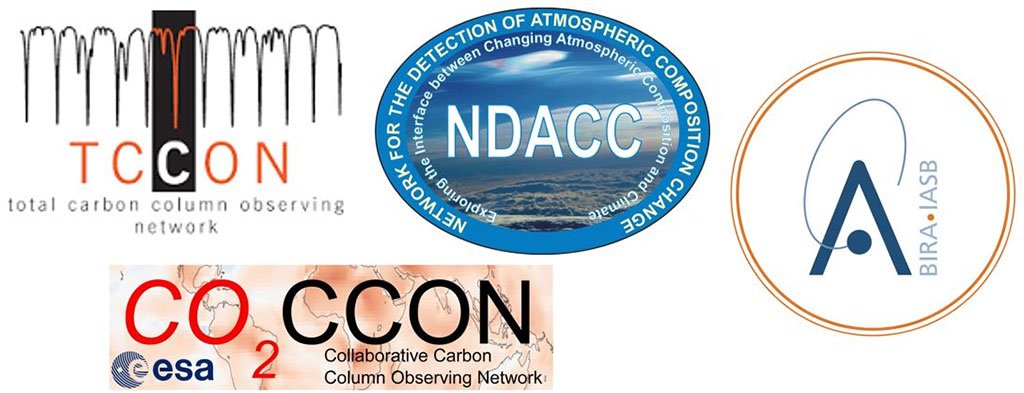
NDACC-IRWG / TCCON / COCCON Annual Meeting 2023
June 1, 2023
The timing of the growing season (vegetation phenology) is impacted by climate change and also influences climate feedback. For example, a longer growing season for a given ecosystem can lead to enhanced carbon sink capacity. Wang and co-authors have used OCO-2 measurements of SIF, combined with animal grazing datasets, to investigate the impacts of grazing activity on the timing of the start and end of the growing season on the Tibetan Plateau. The study finds that higher intensity of grazing impacts soil moisture and soil temperature, leading to shortening of the growing season. For full details of the study, see here: Grazing alters vegetation phenology by regulating regional environmental factors on the Tibetan Plateau
May 5, 2023
A new study by Metz and co-authors uses OCO-2 and GOSAT measurements to show that semi-arid regions in Australia "breathe out" pulses of carbon dioxide at the end of the dry season. The pulses are driven by processes in the soil that occur after the onset of rainfall but before the photosynthetic uptake from vegetation. These results have significant implications for our understanding and modeling of global climate–carbon cycle feedbacks.
The full article can be found here: Soil respiration-driven CO2 pulses dominate Australia’s flux variability
April 28, 2023
OCO-2 and OCO-3 will have a booth at the Explore JPL event this weekend: https://explore.jpl.nasa.gov/
As part of that event, we will be presenting a talk on Carbon from Space on the hyperwall.
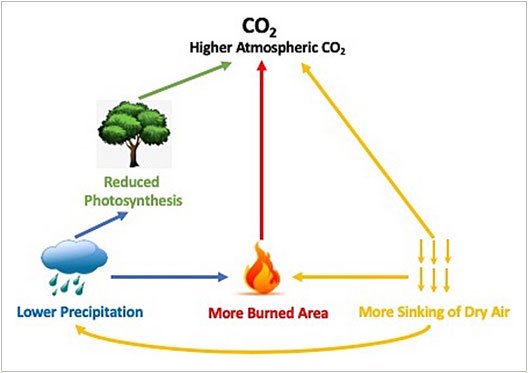
Diagram to demonstrate the impact of dry/fire conditions on atmospheric CO2
April 20, 2023
Jiang and co-authors have used OCO-2 observations to show that the Congo Basin rainforest is a net source of carbon during the dry season. The Congo Basin rainforest is the second biggest and most pristine in the world. The results of this study highlight the impacts of agriculture-driven forest clearing fires in the Congo region and the importance of management and control of these fires.
The full article can be found here: Congo Basin Rainforest Is a Net Carbon Source During the Dry Season
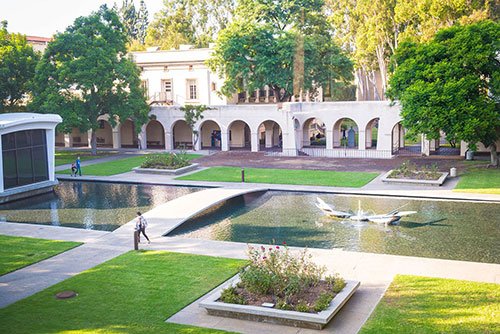
Image of the Caltech Campus
March 24, 2023
OCO-2 and OCO-3 will be holding a Science Team Meeting in Pasadena 28th - 30th March. We look forward to productive interactions and discussions with the team!
Please reach out to our Project Science Management for further info (vivienne.h.payne@jpl.nasa.gov , abhishek.chatterjee@jpl.nasa.gov , junjie.liu@jpl.nasa.gov)
March 13, 2023
A new publication from Byrne and co-authors uses OCO-2 measurements to demonstrate how space-based tools can yield insights on Earth as nations work to achieve climate goals. The international study, conducted by more than 60 researchers, used measurements from Orbiting Carbon Observatory 2 (OCO-2) mission, as well as a network of surface-based observations, to produce a dataset of country-by-country net carbon fluxes as well as carbon stock changes for the years 2015-2020. This dataset was been contributed to the Global Stocktake, a process to assess the world’s collective progress toward limiting global warming, as specified in the 2015 Paris Agreement.
For the press release on this work, see:
NASA Space Mission Takes Stock of Carbon Dioxide Emissions by Countries.
For full details of the study, see:
February 14, 2023
For Valentine's Day, here is a look at CO2 levels over the "City of Love" itself, Paris.
Watch the video: CO2 and the City: Valentine's Day Edition.
February 10, 2023
Feldman and co-authors show that OCO-2 XCO2 data can be used for low-latency monitoring of the monthly timing and magnitude of extreme regional anomalies in biospheric carbon fluxes.
The full details can be found in this recent journal article: Using Orbiting Carbon Observatory-2 (OCO-2) column CO2 retrievals to rapidly detect and estimate biospheric surface carbon flux anomalies.
February 2, 2023
A new study by da Costa et al. utilizes OCO-2 SIF measurements to examine the relationships between SIF and rainfall over Brazil and to quantify how different ecosystems respond to changes in rainfall. The results provide new insight into how these ecosystems could be affected by climate change and extreme weather conditions.
The article can be found here: High spatial resolution solar-induced chlorophyll fluorescence and its relation to rainfall precipitation across Brazilian ecosystems
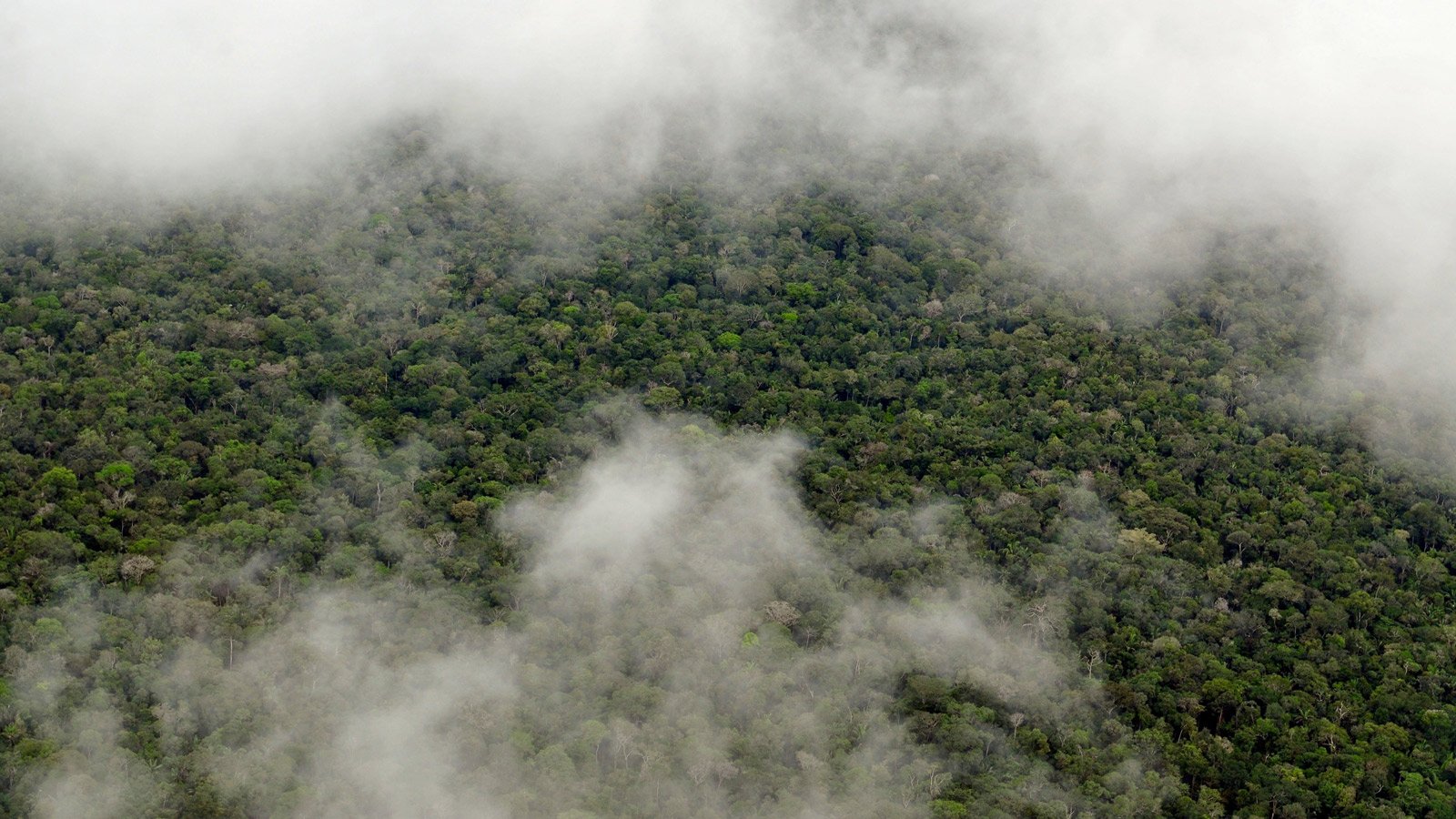
December 8, 2022
A new study by Nassar and co-authors uses OCO-2 and OCO-3 observations to demonstrate spaceborne capability for tracking power plant emissions in close to real time. The full scientific article can be accessed here: Tracking CO2 emission reductions from space: A case study at Europe’s largest fossil fuel power plant.
September 26, 2022
Cressie and co-authors apply a new analysis technique to CO2 flux estimates from the OCO-2 Model Intercomparison Project (MIP) to obtain a statistically optimal consensus result from model output from 9 different teams. This technique allows for weightings that account for common features between models as well as the quality of numerical approximations used within the models. The end result is a more precise and informed consensus on CO2 fluxes than a simple weighted average of results. See full article here: From Many to One: Consensus Inference in a MIP
September 19, 2022
A new story spotlights Brendan Byrne’s research using OCO-2 data: National CO2 Budgets informed by atmospheric CO2 measurements. He is also a co-author of the paper, National CO2 budgets (2015–2020) inferred from atmospheric CO2 observations in support of the Global Stocktake, which is currently under review (comments are invited).
September 8, 2022
Villalobos and co-authors have used OCO-2 measurements to quantify interannual variability in the carbon cycle over Australia and relate the fluctuations to anomalies in vegetation productivity and climate drivers such as precipitation and temperature. This study demonstrates the utility of the multi-year OCO-2 record in evaluating carbon-climate feedbacks on regional scales. See full article here: Interannual variability in the Australian carbon cycle over 2015–2019, based on assimilation of Orbiting Carbon Observatory-2 (OCO-2) satellite data
August 25, 2022
Kang and co-authors have applied a neural approach to downscale the Global OCO-2 SIF (GOSIF) product to the spatial resolution of cotton field parcels. The downscaled SIF estimates were then used to evaluate the feasibility of estimating cotton yields at the field scale. The study demonstrates promise for using satellite SIF products as a basis for estimating agricultural yield on small spatial scales. See full article here: Downscaling solar-induced chlorophyll fluorescence for field-scale cotton yield estimation by a two-step convolutional neural network
August 17, 2022
August 6th marked the 8th anniversary of OCO-2's 'first light' spectra!
A new article covering OCO-2's measurements of CO2 from forest fires can be found here: NASA satellite captures rising carbon dioxide after major forest fires
August 3, 2022
In Mysteries of the Global Carbon Cycle, Dave Crisp and co-authors provide a high level summary of their recently published article describing the natural processes that drive the global carbon cycle. For the full article, please see here: How Well Do We Understand the Land-Ocean-Atmosphere Carbon Cycle?
July 12, 2022
The 18th IWGGMS Meeting is in full swing this week, July 12-14, 2022 (online).
June 22, 2022
Qiu and coauthors have used the GOSIF product (based on OCO-2 measurements of solar induced fluorescence) to evaluate impacts of the 2012 drought on crop yields for corn and soybeans in the U.S. Midwest. Their results show that crop yield anomalies are extremely well correlated with GOSIF anomalies, demonstrating the potential of satellite-based products for monitoring the responses of crop productivity to drought. See full article here: Monitoring drought impacts on crop productivity of the U.S. Midwest with solar-induced fluorescence: GOSIF outperforms GOME-2 SIF and MODIS NDVI, EVI, and NIRv
June 9, 2022
Chevallier and co-authors have applied a simple emissions estimation scheme to OCO-2 and OCO-3 XCO2 measurements over hundreds of large point sources and urban areas over multiple years. They show that OCO-2 and OCO-3 provide robust trends in emission estimates. In addition, OCO-3 cases display a consistent increase in emissions from morning plumes to afternoon plumes, highlighting its ability to capture the diurnal component of emission estimates. See full article here: Large CO2 Emitters as Seen From Satellite: Comparison to a Gridded Global Emission Inventory
May 20, 2022
The NASA Applied Remote Sensing Training Program (ARSET) is currently offering two training courses related to using OCO-2 data. ARSET courses are conducted online at no cost to the participant.
May 2 2022
Check out NASA JPL’s new documentary “Sky High” that includes the OCO-2 origin story. Learn about the highs, lows, and surprises that come with developing space missions.
March 30 2022
David Crisp highlighted the OCO-2 satellite's pioneering efforts in CO2 measurements from space while speaking as a panelist to the White House committee on science and technology. See full article here: JPL Scientist Speaks with White House Committee
March 23 2022
A new video spotlighting OCO-2 and CO2 measurement results during the pandemic is available here: Climate Change and the Pandemic
March 15 2022
'Lan Dang works on the Orbiting Carbon Observatory-2 and Orbiting Carbon Observatory-3 satellites as the Science Data System Lead. When she’s not busy handling the data the satellite sends back, she’s pursuing her other passion: mentoring new hires and local schoolkids.' To read the full interview with Lan, please see here: Spotlight on Lan Dang: Mentoring the next generation
March 9 2022
The hybrid OCO-2/OCO-3 Science Team Meeting will occur next week, March 15 - 17, 2022, 10am - 2pm PST.
March 2, 2022
Sheng and co-authors present a new gridded, long-term XCO2 dataset (Mapping-XCO2) using the XCO2 retrievals from GOSAT and OCO-2 during the period from April 2009 to December 2020, using a geostatistical approach to fill data gaps. The authors suggest that this dataset can be used to investigate XCO2 variations at global and regional scales and to evaluate anthropogenic CO2 emissions and ecological CO2 fluxes. Please see full article here: Global land 1° mapping dataset of XCO2 from satellite observations of GOSAT and OCO-2 from 2009 to 2020
February 23, 2022
"Observing your community can depend greatly on your perspective. A science teacher's dive into local carbon dioxide data provides a point of comparison for what NASA's carbon-monitoring satellite can reveal." To read Mejs Hasan's full article, please see here: Science From the Rooftops
February 17, 2022
A planned decontamination cycle was initiated for the OCO-2 instrument on February 14, 2022. We expect to return to collecting science data in the later half of next week.
During the course of the mission, outgassing of tiny amounts of water vapor, left over from the time that the instrument was still on Earth, leads to accumulation of ice on our detectors, reducing the radiometric throughput. We can use our solar calibration measurements to keep an eye on the impact of this ice as it builds up over time, and we periodically warm up the instrument to avoid too much reduction in the detector response (see figure). As the mission progresses, the ice accumulation has slowed, and these decontamination/warm-ups are needed less frequently. In recent years, we have performed decontamination cycles approximately once per year.
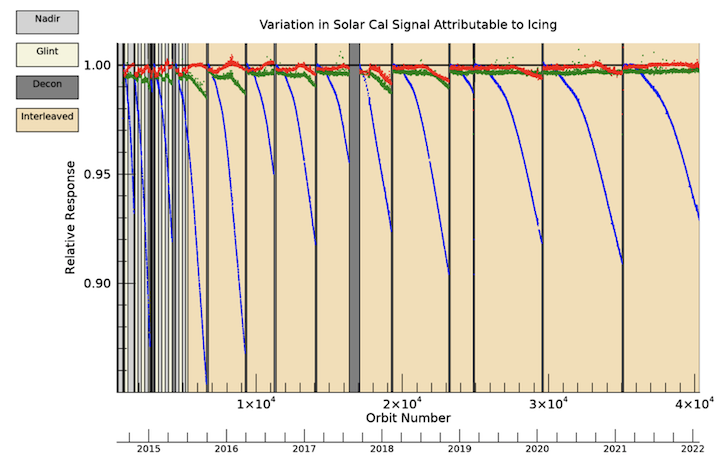
February 10, 2022
Our Science Team are investigating signs of enhanced CO2 in plumes from the January 15th eruption of the Hunga Tonga-Hunga Ha‘apai volcano. Please see here: NASA/JPL satellite captures CO2 data from Tonga volcano
February 2, 2022
On January 20th, Dr. David Crisp gave an overview on "Estimating Carbon Dioxide and Methane Emissions from Space" at a meeting on "Improving Efforts to Measure and Monitor Greenhouse Gas Emissions" for the President’s Council of Advisors on Science and Technology (PCAST). A recording of the presentation can be found here:
President’s Council of Advisors on Science and Technology (PCAST) 2022 Meetings
January 18, 2022
Reductions in human activities in early 2020 due to COVID-19 pandemic led to unprecedented decreases in carbon dioxide (CO2) emissions from burning of fossil fuels. However, the impact of these emissions changes on atmospheric CO2 are small compared to year-to-year changes associated with atmospheric transport and biospheric fluxes, making it challenging to disentangle human-induced changes from natural variability. In a new study using OCO-2 observations of XCO2 together with an integrated Earth System model, Weir and co-authors show that the impact of these short-term, regional changes in fossil fuel emissions on CO2 concentrations was indeed observable from space, indicating that current spaceborne technologies are approaching the levels of accuracy and precision needed to support climate mitigation strategies. Please see here: Regional impacts of COVID-19 on carbon dioxide detected worldwide from space
January 6, 2022
Dr. David Crisp, our illustrious OCO-2/OCO-3 Science Team Lead, will be retiring from JPL at the end of this week. We are incredibly grateful for his leadership and for the energy and enthusiasm he has imbued into so many different aspects of the OCO-2 and OCO-3 projects over the years. Thank you Dave!
December 16, 2021
Brendan Byrne and co-authors combined observations from multiple satellites, including OCO-2, to quantify the disruption to the carbon cycle due to drought and bushfires in southeast Australia during 2019–2020. The drought and bushfires resulted in a carbon loss from these ecosystems that is greater than Australia's annual fossil fuel emissions, although the carbon is expected to be drawn back into these ecosystems as the forests recover. Please see here: The Carbon Cycle of Southeast Australia During 2019–2020: Drought, Fires, and Subsequent Recovery
December 13, 2021
The AGU 2021 Meeting is in full swing this week.
November 11, 2021
The annual OCO-2 End of Year Review for 2021 concluded after reviewing all aspects of the project and the performance trends of the observatory and instrument. Overall, the hardware is performing well and we look forward to many more years of continued successful science operations and acquiring high quality data to support advances in carbon cycle science.
November 4, 2021
Members of our Science Team, including Dave Crisp (OCO-2/OCO-3 Science Team Lead), are participating in the COP26 Climate Summit this week. The team’s work on the Global Stocktake, a provision in the Paris accords that calls for reviewing the state of global emissions every 5 years, is referenced in the following News article in Science this week: On eve of climate summit, researchers sharpen emissions tracking
October 27, 2021
Friday October 22 saw the final day of the OCO-2/3 Science Team Meeting. This was held virtually and was preceded by many breakout sessions to cover all aspects of the Project and Science Team’s research and work, and 4 days of full plenary meetings. Over 160 people registered for the meeting. Participants showed great interest and joined in discussions on the progress and new research directions being presented. As the relatively new V10 data from both OCO-2 and OCO-3 are being more widely used by the community, new aspects of the carbon cycle are being studied. https://disc.gsfc.nasa.gov/datasets?page=1&source=OCO-2%20OCO-2
October 20, 2021
The virtual OCO-2/OCO-3 Science Team Meeting is in full swing this week.
October 14, 2021
It is more or less now well known that the OCO-2 observations can be used to detect the small solar induced chlorophyll fluorescence signals from plants, but in the analysis of these signals, Kohler and co-authors report an even smaller signal can be detected over barren surfaces from the luminescence of minerals. They found the signal over around 10% of barren surfaces and likely associated with the presence of trace amounts of Mn2+ in minerals. Please see here: Mineral Luminescence Observed From Space
October 6, 2021
Breakout sessions are underway this week in preparation for the Fall OCO-2/OCO-3 Science Team Meeting, to be held October 19-22, 2021.
September 22, 2021
A new study by Chevallier utilizes OCO-2 observations in “fast track” CO2 flux inversions, making use of the fact that satellite products are available faster than the surface observations that are generally used as reference. This study highlights the potential for OCO-2 (and future satellite datasets) to enable quasi-near-real-time estimation of CO2 fluxes that can be used to directly inform CO2 flux accounting for managed lands in large countries or groups of countries. Please see here: Fluxes of Carbon Dioxide From Managed Ecosystems Estimated by National Inventories Compared to Atmospheric Inverse Modeling
September 8, 2021
The role of OCO-2 measurements of CO2 and SIF in expanding observational capacity and providing sustained measurements of key climate variables is highlighted in the recently released Intergovernmental Panel on Climate Change Sixth Assessment Report (IPCC AR6). This report provides a scientific basis for governments at all levels to develop climate related policies. The full report can be found here: IPCC Sixth Assessment Report
September 3, 2021
Zichong Chen and co-authors use OCO-2 observations to quantify relationships between patterns in atmospheric CO2 and environmental drivers of CO2 fluxes, such as temperature, precipitation and availability of sunlight. The observed relationships are compared with those generated using 15 different terrestrial biosphere models. This work demonstrates the potential for using spaceborne observations to inform key relationships that are currently very uncertain in models. Linking global terrestrial CO2 fluxes and environmental drivers: inferences from the Orbiting Carbon Observatory 2 satellite and terrestrial biospheric models
September 2, 2021
The synergistic use of different satellite data is an important feature of the paper by Xing Li and co-authors, coupling SMAP soil moisture with OCO-2 solar induced fluorescence to study the impact of the 2018 drought in the United States. The satellite data revealed the impact of the drought on plant productivity and provided good estimates of crop yield. Please see here: Synergistic use of SMAP and OCO-2 data in assessing the responses of ecosystem productivity to the 2018 U.S. drought
August 19, 2021
Qinwei Zhang and co-authors describe a method of combining regional scale models and OCO-2 data in flux inversions to recover CO2 emission hotspots over continental north America, coincident with major urban centers. This and other techniques may provide new “top-down” information useful to support the next global stock take. Please se here: CO2 Flux over the Contiguous United States in 2016 Inverted by WRF-Chem/DART from OCO-2 XCO2 Retrievals
August 4, 2021
In a new analysis of OCO-3 data, with comparison to a baseline of OCO-2 observations, Raychaudhuri and Roy show that even over a short timescale, OCO-3 XCO2 can be used to detect the impact of the COVID-19 pandemic in the reduction of CO2 emissions in nine heavily populated urban regions around the world (note: this publication is an early release). Please see here: A Proof of Concept for Estimating the Annual Atmospheric Carbon Dioxide Variation From Orbiting Carbon Observatory-3 vEarly Data
July 27, 2021
Hu and co-authors use OCO-2 XCO2 measurements to estimate emissions for two coal-fired power plants in China, providing an example of the potential for satellite monitoring of large point sources. Please see here: Estimating CO2 Emissions from Large Scale Coal-Fired Power Plants Using OCO-2 Observations and Emission Inventories
July 1, 2021
Schuh and co-authors introduce a multi-scale modeling framework that provides a key step towards utilization of high resolution greenhouse gas datasets for monitoring urban CO2 emissions. This framework provides a means to account for atmospheric signals from sources and sinks outside the area of interest when quantifying emissions from urban areas. The team utilize estimates of natural and anthropogenic CO2 fluxes from the OCO-2 Model Intercomparison Project in their model simulations. Please see here: Far-field biogenic and anthropogenic emissions as a dominant source of variability in local urban carbon budgets: A global high-resolution model study with implications for satellite remote sensing
June 23, 2021
Jiao et al. have utilized OCO-2 solar induced fluorescence measurements to evaluate the robustness of relationships between vegetation growth and water availability in the extratropical Northern Hemisphere. Their findings suggest that vegetation is becoming more susceptible to drought over time. Please see here: Observed increasing water constraint on vegetation growth over the last three decades
June 17, 2021
Russell Doughty and co-authors utilize OCO-2 SIF retrievals and the v8 SIF Lite data product to examine the changes and anomalies to greenness, SIF and photosynthesis during dry seasons, El Niño and La Niña events in the Amazon Basin 2007-2017. Please see here: Small anomalies in dry-season greenness and chlorophyll fluorescence for Amazon moist tropical forests during El Niño and La Niña
June 16, 2021
Many OCO-2 science team members are participating in the 17th IWGGMS this week. For workshop meeting information, please see here: The 17th International Workshop on Greenhouse Gas Measurements from Space
June 9, 2021
We would like to give a mighty shout-out and thank you to TCCON for supporting OCO-2 as the vital ground-based resource for our data validation! The TCCON/COCCON virtual meeting is happening this week, June 8th-10th. For more meeting information, please see here: TCCON/COCCON 2021 Virtual Meeting
May 27, 2021
OCO-2 solar induced fluorescence has been used to confirm model predictions anomalous gross primary productivity (GPP, or the amount of carbon fixed by the ecosystem during photosynthesis) associated with the Indian Ocean Dipole (IOD) in 2019. The IOD, a major climate variability in the tropics associated with heavy rain and severe droughts, is predicted to occur more frequently in future warming scenarios but has so far not been well studied in terms of impacts on the carbon cycle. This study provides valuable new insights into the role of the IOD in regional and global carbon cycle interannual variability. Please see: Modulation of Land Photosynthesis by the Indian Ocean Dipole: Satellite-Based Observations and CMIP6 Future Projections
May 19th, 2021
The sister instrument to OCO-2, the OCO-3 instrument mounted on the International Space Station, can scan over larger areas to create Snapshot Area Maps. Observations in this mode over Los Angeles reveal intra-urban variations of XCO2 over the city that have never been observed from space before. The spatial variations are mainly driven by the complex fossil fuel emission patterns and meteorological conditions in the LA Basin and are in good agreement with those from co-located TROPOMI measurements of nitrogen dioxide (NO2), a co-emitted pollutant. Please see: Urban-focused satellite CO2 observations from the Orbiting Carbon Observatory-3: A first look at the Los Angeles megacity
May 6, 2021
OCO-2 data for a 5 year period has been used to test the understanding of the key processes that determine year-to-year differences in uptake (or release) of carbon dioxide in different in different regions. Zichong Chen and co-authors show that the data supports as large role in the tropics for grasslands, savannah, and agriculture as the forested areas. This is not well represented in magnitude in many models describing the behavior of these terrestrial ecosystems. Please see: Five years of variability in the global carbon cycle: comparing an estimate from the Orbiting Carbon Observatory-2 and process-based models
May 4, 2021
In celebration of the Crew-2 launch broadcast and Earth Day, Annmarie Eldering (Deputy Project Scientist for OCO-2, Project Scientist for OCO-3), gave a brief interview on Friday, April 23, 2021. This Teams interview was hosted by The International Space Station Program Research Office. Please see video here:
April 28, 2021
NASA has announced results and selections from the latest round of OCO-2/3 Science Team ROSES proposals. We want to welcome new and returning Science Team members (listed below). For more details, please see: NASA Science Mission Directorate Research Opportunities in Space and Earth Sciences–2020 NNH20ZDA001N-OCOST A.51 Science Team for the OCO Missions.
International team members:
April 28, 2021
The Amazon basin has been thought of as the “lungs of the planet” and a reliable carbon sink. Since 2017, researchers have found increasing evidence that anthropogenic practices have decreased the basin’s ability to capture carbon. Using OCO-2 and AIRS data, Jiang and co-authors show that the basin, during the dry/fire season (August through October), is a net carbon source, with elevated CO2 concentrations in the basin compared to the surrounding region. Please see: Impact of Amazonian Fires on Atmospheric CO2
April 22, 2021
Happy Earth Day! We are celebrating with a new launch to the ISS. Check out the SpaceX interview video with Dr. Annmarie Eldering in 'Galleries'.
April 13, 2021
With the continuing interest in understanding the relationship between solar induced fluorescence (SIF) and gross primary productivity (GPP), as an important measure of ecosystem activity, Yu Bai and co-authors use machine-learning methods to explore the relationship together with other auxiliary data sets. Please see: Estimating Global Gross Primary Production from Sun-Induced Chlorophyll Fluorescence Data and Auxiliary Information Using Machine Learning Methods
April 1, 2021
The Hayoung Park and co-authors use OCO-2 CO2 together with S-5P TROPOMI CO and NO2 measurements to study regional emission characteristics of different cities, and consider which factors may influence the relationship between CO2 and air pollutants. Although the observations span just 15 months, the authors consider how sustained observations might inform strategies for mitigating climate and air pollution. Please see: An assessment of emission characteristics of Northern Hemisphere cities using spaceborne observations of CO2, CO, and NO2
March 24, 2021
The OCO-2/3 missions successfully completed the virtual science team meeting March 15-18, 2021. Please keep in mind that the next meeting is scheduled for October 18-22, 2021.
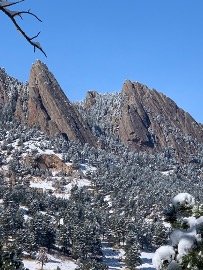
September 21, 2020
The OCO-2/OCO-3 missions will have a virtual science team meeting October 19-23, 2020! Breakout sessions begin 9/28 through 10/15. Please check out the breakout plan and further details on the main site.
We will certainly miss seeing everyone in beautiful Boulder, but looking forward to seeing your friendly faces online. For more information, please visit the links below. If you have additional questions, please reach out to Dr. Annmarie Eldering, annmarie.eldering@jpl.nasa.gov.
Main page: https://sites.google.com/view/oco2oco3stm1020/home
iPoster sign up: https://sites.google.com/view/oco2oco3stm1020/iposter-signup
August 12, 2020
The “official” OCO-2 v10r L2 FP, L2 Diagnostic, L2 XCO2 Lite, and SIF Lite products are now posted on the GES DISC for global access: Click Here.
The current products are the reprocessed results of the entire OCO-2 data record, extending across the entire mission from 2014-09-06 to 2020-07-30. These results supersede and should replace the v10r beta products distributed earlier for internal review.
For more details, please click here.
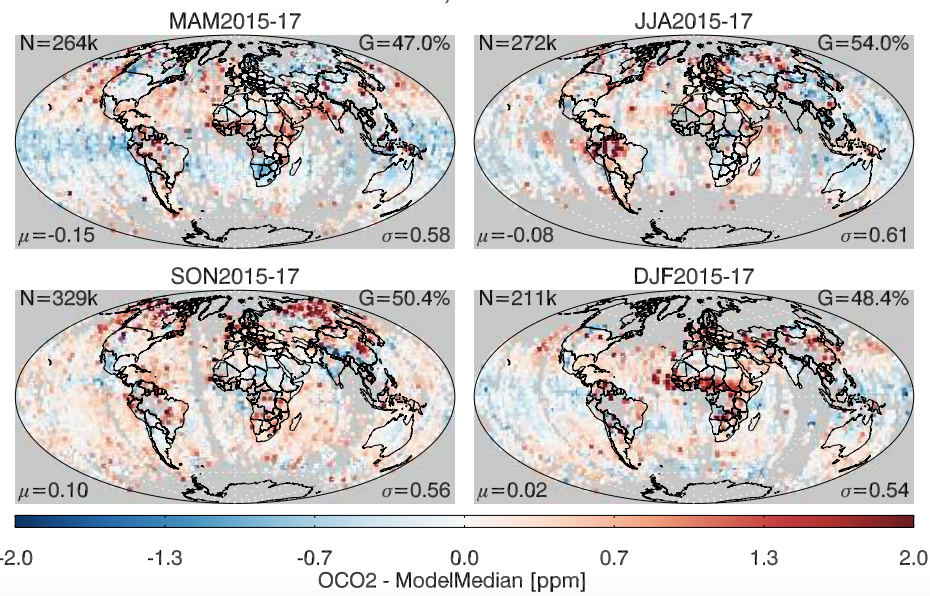
July 28, 2020
Over the last few months, OCO-2 has been finishing the reprocessing of the entire OCO-2 data record (2014 to present). This new version, version 10 or V10, reflects updates to the data processing software to "improve the quality of the now five and three-quarter year record of atmospheric Carbon Dioxide (XCO2) and Solar Induced Chlorophyll Fluorescence (SIF)". There will be an announcement in August at the GES DISC when the whole data set is available with supporting documentation to describe how to use the data. Please learn more here.